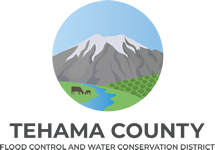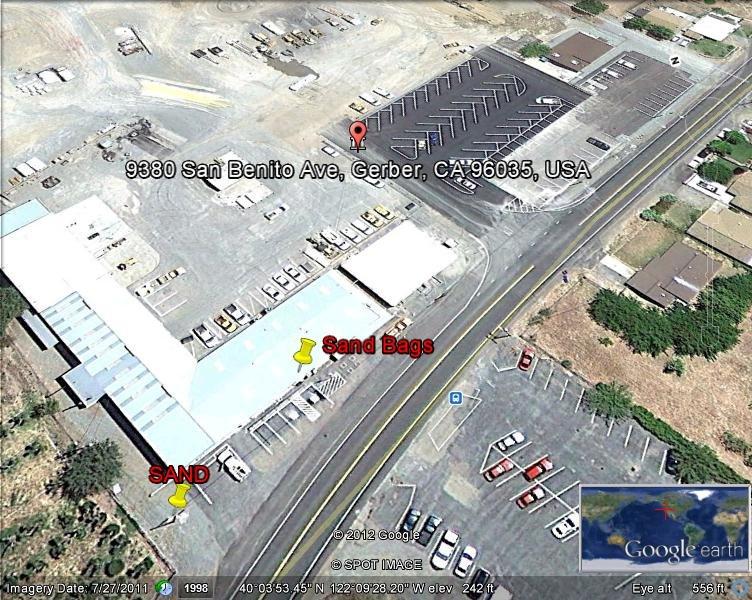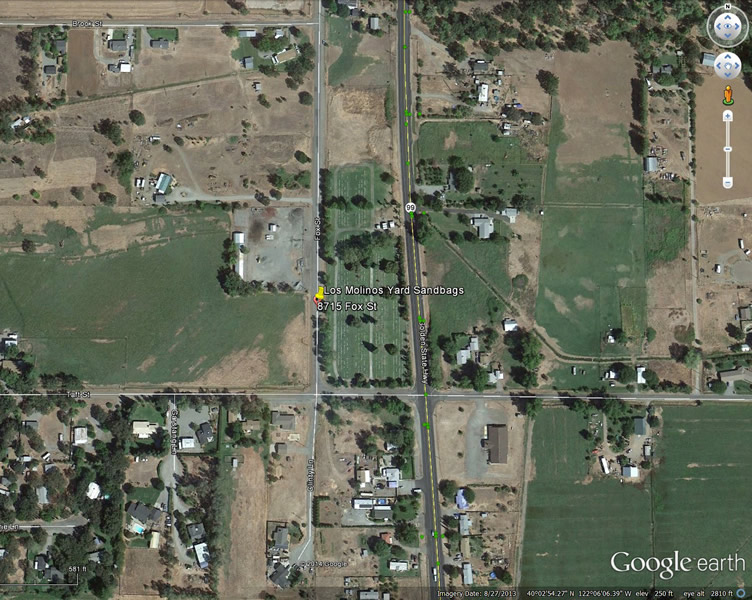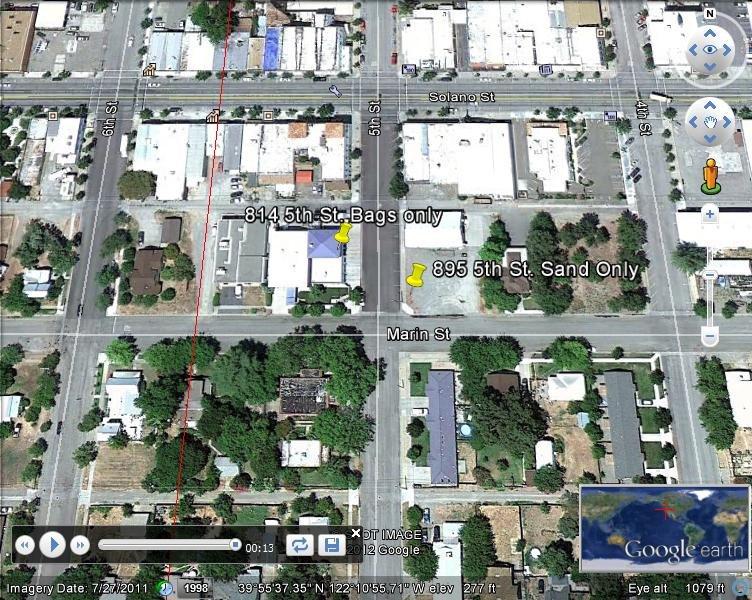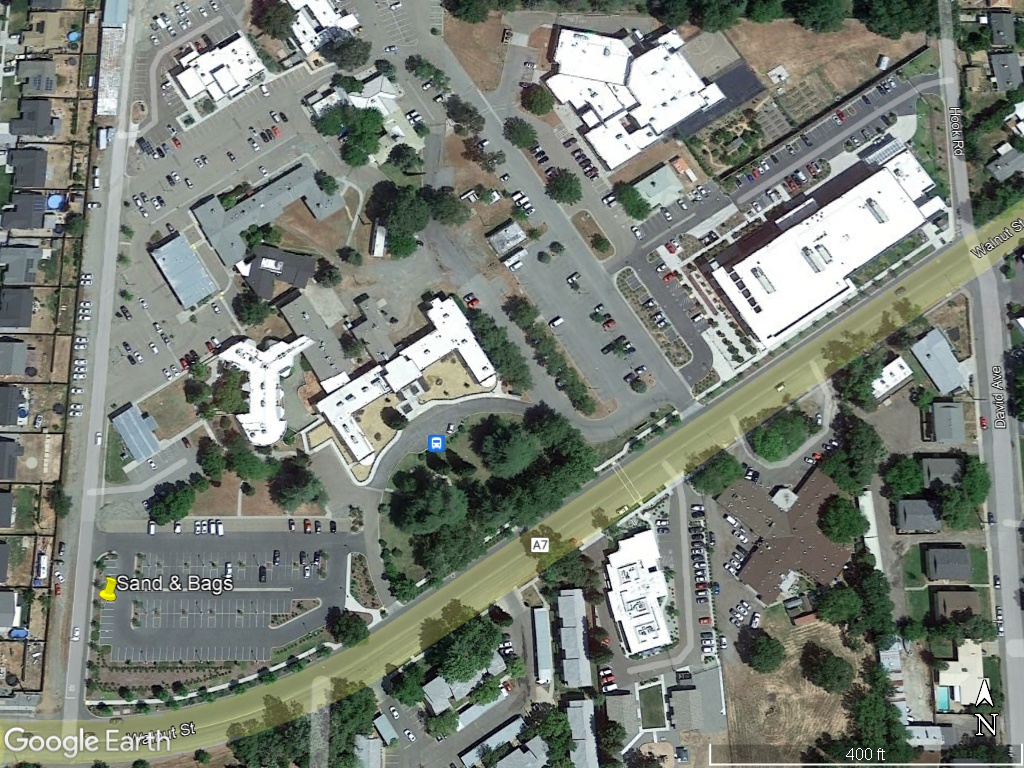Emergency Flood Information
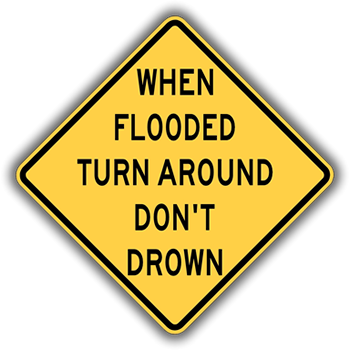
In case of emergency, call 911
For non-emergency issues, please contact the appropriate agency below:
Tehama County
Sheriff’s Office
Tehama County
Public Works
City of Corning
City of Red Bluff
City of Tehama
Caltrans
2-1-1 Tehama
2-1-1 Tehama connects people with community services in Tehama County.
Sandbags
Tehama County Flood Control and Water Conservation District will make sand and sandbags available in limited quantities prior to large storm events that are predicted to cause flooding. Sand and sandbags can be purchased at several local hardware stores and landscape suppliers.
The locations below will be highlighted in RED when sand and sandbags will be stocked.
Tehama County will make sand and sandbags available in limited quantities prior to large storm Citizens are encouraged to ‘only take what they need’ and to bring their own shovels to fill bags. While sandbags can be effective in emergency situations, citizens with repetitive flooding problems are encouraged to find more permanent solutions.
Using sandbags is a simple, but effective way to avoid or reduce flood water damage. Properly filled and placed sandbags can act as a barrier to divert moving water around, instead of through, buildings. Sandbag construction doesn't guarantee a water-tight seal, but is satisfactory to be used in most situations. Sandbags are also used successfully to avoid overtopping of streams with levees, and for training current flows to specific areas.
Flood Fighting At Home
Easy Ways To Keep Water Out of Your House
During the times of heavy rains, most damage to homes and property comes from flooded streets, particularly those with blocked drains. Be sure your gutters are clear of leaves and debris. Low curbs and sloping driveways also pose a problem. Your home can be protected by redirecting the water flow. Sandbag walls can be used to divert water or mud. Place the sandbag walls so they channel the water to a clear drain or gutter.
Flood Insurance Rate Maps
The official map of a community on which FEMA has delineated both the special hazard areas and the risk premium zones applicable to the community. The purpose of this page is to define a Flood Insurance Rate Map (FIRM), a commonly used term in floodplain management.
Natural Resource Conservation Service (NRCS)
NRCS helps America’s farmers, ranchers and forest landowners conserve the nation’s soil, water, air and other natural resources. All programs are voluntary and offer science-based solutions that benefit both the landowner and the environment.
Flood Safety Tips From FEMA
Do Not Walk Through Flowing Water.
Six inches of water can knock you off your feet. Drowning is a major cause of flood deaths. Most of these drowning deaths occur during flash floods. Use a pole or stick to make sure that the ground is still there before you go through an area where the water is not flowing.
Do Not Drive Through A Flooded Area.
More people drown in their cars than anywhere else. If you come upon a road barrier, turn around and go another way; the road or bridge may be washed out.
Stay Away From Power Lines and Electrical Wires.
Electrocution is also a major killer in floods. Electrical current can travel through water. Report downed power lines to our utility company or emergency manager.
Turn Off Your Electricity When You Return Home.
Some appliances, such as television sets, can shock you even after they have been unplugged. Don't use appliances or motors that have gotten wet unless they have been taken apart, cleaned, and dried by a professional.
Watch For Animals - Especially Snakes.
Small animals that have been flooded out of their homes may seek shelter in yours. Use a pole or stick to poke and turn items over and scare away small animals.
Look Before You Step.
After a flood, the ground and floors are covered with debris including broken bottles and nails. Floors and stairs that have been covered with mud can be very slippery.
Be Alert For Gas Leaks.
Use a flashlight to inspect for damage. Don't smoke or use candles, lanterns, or open flames unless you are sure that the gas has been turned off and the area has been aired out.
Carbon Monoxide Exhaust Kills.
Use a generator or other gasoline-powered machines outdoors. The same goes for camping stoves. Fumes from charcoal are especially deadly – cook with charcoal only outdoors.
Clean Everything That Got Wet.
Floodwaters have picked up sewage and chemicals from roads, farms, factories, and storage buildings. Spoiled food and flooded cosmetics and medicine are health hazards. When in doubt, throw them out.
Take Good Care of Yourself.
Recovering from a flood is a big job. It is tough on both the body and the spirit. And the effects a disaster has on you and your family may last a long time. Consult a health professional on how to recognize and care for anxiety, stress, and fatigue.
Tips To Reduce Loss of Life and Property
Steps To Take Today
Make an itemized list of personal property, including furnishings, clothing, and valuables. Photographs of your home (inside and out) are helpful. These will assist your insurance adjuster in settling claims and will help prove uninsured losses, which are tax deductible.
Learn the safest route from your home or place of business to high, safe ground if you should have to evacuate in a hurry.
Keep a portable radio, emergency cooking equipment, and flashlights in working order, and keep extra batteries on hand.
Buy flood insurance. You should contact your property/casualty agent or company about flood insurance, which is offered through the National Flood Insurance Program. Effective March 1, 1995, there is a 30 day waiting period (with two exceptions) for this policy to become effective, so don't wait until a flood is coming to apply.
Keep your insurance policies and a list of personal property in a safe place, such as a safe deposit box. Know the name, phone number, and location of the agent(s) who issued your policies.
Persons who live in frequently flooded areas should keep on hand materials such as sandbags, plywood, plastic sheeting, and lumber which can be used to protect property. (Remember, sandbags should not be stacked directly against the outer walls of a building, since, when wet, the bags may create added pressure on the foundation).
When The Flood Comes
Safety is the most important consideration. Since floodwaters can rise very rapidly, you should be prepared to evacuate before the water level reaches your property.
Keep a battery powered radio tuned to a local station, and follow all instructions for your area. Be prepared to evacuate.
When outside the house, remember…FLOODS ARE DECEPTIVE. Avoid flooded roads, and don't attempt to walk through floodwaters.
If, and only if, time permits, there are several precautionary steps that can be taken:
- Turn off all utilities at the main power switch and close the main gas valve if evacuation is likely. Do not touch and electrical equipment unless it is in a dry area and you are standing on a piece of dry wood while wearing rubber gloves and rubber-soled boots or shoes
- Move valuable papers, furs, jewelry, clothing, and other contents to upper floors or higher elevations
- Fill bathtubs, sinks, and jugs with clean water in case regular supplies are contaminated. You can sanitize these items by first rinsing with bleach
- Board up windows or protect them with storm shutters
- Bring outdoor possessions inside the house or tie them down securely. This includes lawn furniture, garbage cans, tools, signs, and other moveable objects that might be swept away or hurled about.
If it is safe to evacuate by car, you should consider the following:
- Stock the car with nonperishable foods (like canned goods), a plastic container of water, blankets, first aid kit, flashlights, dry clothing, and any special medication needed by your family
- Keep the gas tank at least half full since gasoline pumps will not be working if the electricity is cut off.
Do not drive where the water is over the roads. Parts of the road may already be washed out.
If your car stalls in a flooded area, abandon it as soon as possible. Floodwaters can rise rapidly and sweep a car (and its occupants) away. Many deaths have resulted from attempts to move stalled vehicles.
If you're caught in your home by rising waters, move to the second floor and, if necessary, to the roof. Take warm clothing, a flashlight, and a portable radio with you. Then wait for help…don't try to swim to safety. Rescue teams will be looking for you.
After The Flood
If your home, apartment, or business has suffered flood damage, immediately call the agent or company who handles your flood insurance policy. The agent will then submit a loss form to the National Flood Insurance Program. An adjuster will be assigned to inspect your property as soon as possible.
Prior to entering a building, check for structural damage. Make sure it is not in danger of collapsing. Turn off any outside gas lines at the meter or tank. If you smell gas, call your utility company immediately.
Upon entering the building, do not use an open flame as a source of light since gas may still be trapped inside – use a battery-operated flashlight.
Watch for downed electrical wires. Make certain that the main power switch is turned off. Do not turn on any lights or appliances until an electrician has checked the system for short circuits.
Cover broken windows and holes in the roof or walls to prevent further weather damage.
Proceed with immediate clean-up measures to prevent any health hazards. Perishable items pose a health problem and should be listed and photographed before discarding. Throw out fresh food and medicines that have come in contact with floodwaters.
Water for drinking and food preparation should be used only if the public water system has been declared safe. In and emergency, water may be obtained by draining a hot water tank or melting ice cubes.
Take pictures of the damage to your building and contents. Refrigerators, sofas and other hard goods should be hosed off and kept for the adjuster's inspections. Use a household cleanser to clean items to be kept. any partially damaged items should be dried and aired; the adjuster will make recommendations as to repair or disposal.
Take all wooden furniture outdoors to dry, but keep it out of direct sunlight to prevent warping. A garage or carport is a good place for drying. Remove drawers and other moving parts as soon as possible, but do not pry open swollen drawers from the front. Instead, remove the backing and push the drawers out.
Shovel out mud while it is still moist to give walls and floors a chance to dry. Once plastered walls have dried, brush off loosed dirt. Wash with household cleanser and rinse with clean water; always start at the bottom and work up. Ceilings are done last. Special attention must also be paid to cleaning out heating ducts and plumbing systems.
Mildew can be removed from dry wood with a solution of 1 cup liquid chlorine bleach, in 1 gallon of water.
Clean metal at once then wipe with a kerosene-soaked cloth. A light coat of oil will prevent iron from rusting. Scour all utensils, and, if necessary, use fine steel wool on unpolished surfaces. Aluminum may be brightened by scrubbing with a solution of vinegar, cream of tartar, and hot water.
Quickly separate all laundry items to avoid running colors. Clothing or household fabrics should be allowed to dry (slowly, away from direct heat) before brushing off loose dirt. If you cannot get a professional cleaner, rinse the items in lukewarm water to remove lodged soil. Then wash with mild detergent; rinse and dry in sunlight.
Flooded basements should be drained and cleaned carefully. Structural damage will occur if water is pumped out too quickly. After the floodwaters around your property have subsided, begin draining the basement in stages, about one-third of the water volume each day.
Are You Protected From The Next Disaster?
In July of 1993 almost no one in the Midwest expected flooding, until the rain started falling – and didn't stop. Rivers and streams, already swollen from heavy spring rains and snowmelt, rose rapidly to record flood levels. After two months, the Missouri and Mississippi rivers had surged through nine states, destroying homes, businesses and croplands in towns and cities across the Midwest. It was a summer no one in the Midwest will ever forget. The Great Flood of '93 was the worst in U.S. history, causing 48 deaths, and an estimated $10.5 billion in damage to 45,000 homes and $6.5 billion to crops.
Devastating floods occur throughout the U.S. every year. Overdevelopment and leveling of forests have reduced the land's natural ability to absorb excess water. So with little warning, heavy rains can bring disastrous floods – even if you don't live near a river or stream.
Flooding As A National Problem
Until the late 1960's, most property owners were unable to get insurance against flood damage. Private insurance firms, aware of the potential for catastrophic losses, were unwilling to assume the financial risk alone. This put the burden on taxpayers to provide costly disaster relief to a growing number of flood victims.
In 1968, Congress addressed this issue by creating the National Flood Insurance Program (NFIP). This Federal program provided flood insurance at a reasonable cost in exchange for the careful management of flood-prone areas by local communities.
Today, the NFIP serves over 2 million policyholders in more than 18,000 communities across the country. It is administered by the Federal Emergency Management Agency (FEMA).
Your Homeowners Policy Isn't Enough
Losses due to flooding are not covered under most homeowners or business policies. No one, however, should be without financial protection from flood disaster. You can insure your home or business, and its contents, if your community is in the NFIP. to participate, a community must adopt and enforce floodplain management regulations to reduce future flood damage.
You can buy flood insurance in NFIP communities no matter where your home or business is located¹. Even if you are in an area that is not considered to be flood-prone, it's a good idea to have flood insurance. One-third of all NFIP claims come from outside high-risk flood areas.
To find out more about flood insurance and whether your community is participating, ask any licensed property agent or company – the same person who sells your home and auto policies.
¹except in Coastal Barrier Resources areas (P.L. 97-348)
Facts You Should Know
Compared to a fire, people in floodplains are 27 times more likely to have a flood during their 30 year mortgage.
Find out whether you are located in a floodplain – a special flood hazard area. Contact your city or county government (start with the Building or Planning Department) and ask to see the Flood Insurance Rate Maps published by FEMA. These maps are available for public inspection. if your building is located in a flood zone that begins with the letter A or V, you are in a special flood hazard area.
In low – to moderate-risk areas, coverage is available for as little as $80 per year. The average premium in high-risk areas is about $300 per year.
Buy as much flood coverage as you can. Primary residences insured for 80% of their value, or the maximum amounts available, get replacement cost coverage. It pays the amount needed to replace the building elements, without deduction for depreciation.
There is a 30-day waiting period from the time a policy is purchased until you are covered, with the following exceptions:
- If the initial purchase of flood insurance is in connection with the making, increasing, extending or renewing of a loan, there is no waiting period. The Coverage becomes effective at the time of the loan, provided application and presentment of premium is made at or prior to loan closing
- If the initial purchase of flood insurance is made during the one-year period following the issuance of a revised flood map for a community, there is a one-day waiting period.
Flood insurance is required by law to get Federally secured financing to buy, refinance, build, repair, reconstruct, or improve structures in special flood hazard areas of a participating community. This includes Federal grants, FHA and VA loans, as well as most conventional mortgage loans.
The NFIP not only covers flood losses to your building or contents, it also reimburses you for actions you take to prevent flood damage. For example, costs for removing insured contents to a safe location are reimbursed up to $500 with no deductible. Other costs, such as for sandbags, plastic sheeting and lumber, pumps, fill for temporary levees, and wood to save the building can also be reimbursed up to a limit of $750 with no deductible.
The Next Steps Are Up To You
At a time when flooding causes more than $2 billion in property damage each year, you cannot afford to think that it will never happen to you. It can happen, and often when it's least expected.
But you must act in advance. Call your insurance agent or company to purchase flood insurance today. For more information on steps you can take to prepare for and reduce flood damage, contact FEMA or the American Red Cross.
